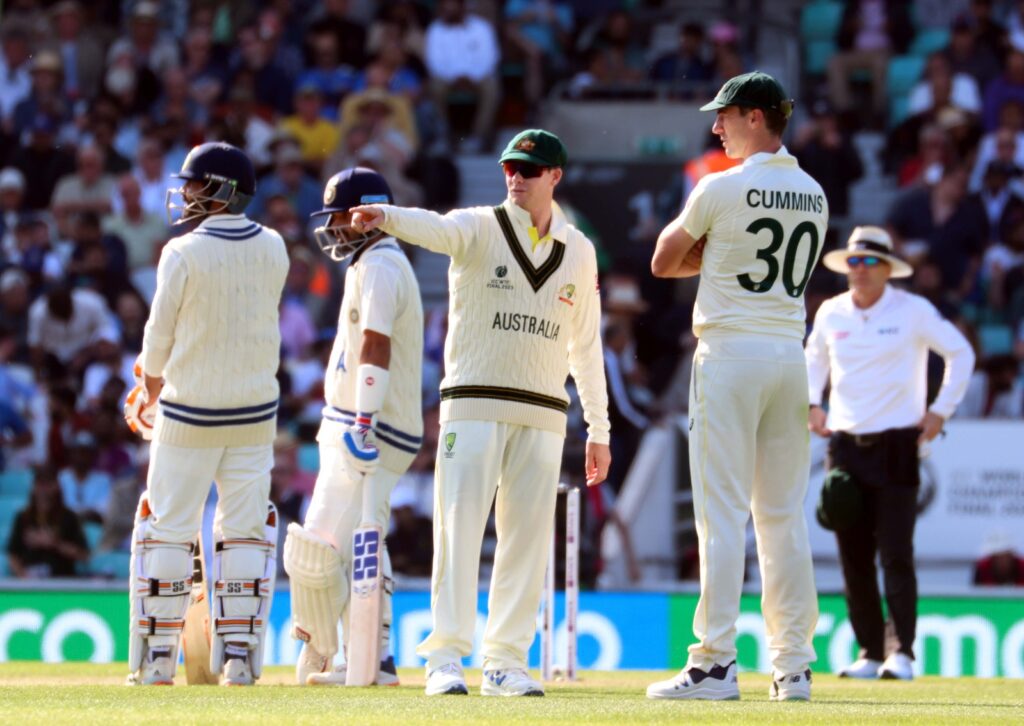
This was Test-match cricket at its best. It was so heartening to see the Indian bowlers making a comeback on day two of the World Test Championship final. It was obvious that Paras Mhambrey, the bowling coach, had a real good chat with the bowlers, and drilled into them where they erred on the opening day, and how they could mend that. And mend they did.
India did get some luck because both David Warner, on day one, and Travis Head, who was looking good for a double-hundred, were stifled down the leg side. Now that is a mode of dismissal one cannot plan, although the short-ball ploy was used superbly against Head on Thursday. It made us all wonder why the same was not deployed on the opening day, especially first up.
When India came out to bat, rather buoyant after their morning display, the two openers were welcomed with some high-class and, most importantly, very accurate fast bowling –
accurate being the key word. It did not start off well for the Aussies with the ball. Mitchell Starc looked off-colour in his brief spell, and there were some freebies on offer.
It was excellent captaincy by Pat Cummins, who quickly realised that his big left-arm seamer was not totally in control of the way the ball was coming out of his hand. He got his banker, Scott Boland, into the attack before the batters were set. The reason I harp on this is because sometimes captains end up giving an extra couple of overs to their premier bowler to hit his straps. If that takes a while to happen, the batters get set.
Cummins saw the danger of this and was proactive, and it also helped that he has a bowler, in Boland, who can bowl on a coin. The reason for that is attributed to the fact that he plays his domestic cricket at the Melbourne Cricket Ground on a drop-in pitch, and the margin for error for bowlers is minimal. It is a belter to bat on, and bowlers who achieve success on such wickets have discipline right at the top of their skill-set. Ravindra Jadeja, in Rajkot, and Axar Patel, in Ahmedabad, are examples of that, closer to home.
What a bowler Boland is, and what a start he has had to his Test career and this game. Before this game, his bowling average was around 13 after eight test matches. And it’s the lengths that Cummins and Boland bowled in tandem that did both for the Indian openers. A leg-before decision, against Rohit Sharma, and Shubman Gill bowled shouldering arms justified the length they bowled. They were relentless. Now, we are often hard on many bowlers for bowling a tad too short. It often happens because when you try to pitch it up, if you are a couple of inches off the spot on the fuller side, it becomes a half-volley. At this level, that could mean leaking runs. So for a fast bowler to have this ability to be able to hit the top of off stump, and yet not bowl that half-volley is a very special quality.
Also Read: Australia Have India on the Rack After Piling up 469
Pujara, who looked as solid as ever, also paid the price of having bowlers asking him questions every ball. As a batter, when that ball leaves the bowler’s hand and it is going to hit the stumps, it has your full attention. It’s the ball that all batters dread. Rohit was stuck in the crease, and Gill and Pujara both completely flummoxed by the ball jagging back after pitching. Seam movement rather than swing, and if you ask any batter which one of the two they dread more, a whopping majority would pick seam.
Starc who had an up-and-down day, produced a peach of a delivery to get Virat Kohli. Many will say that Kohli could have let that ball go, but with that forward press of his, he was already committed to playing the shot. Even someone as great as Kohli has been over a decade got sucked into edging to the slips, and a really good catch by Steven Smith.
Ajinkya Rahane, only here because of the unavailability of KL Rahul and Shreyas Iyer was further helped by Pat Cummins overstepping when he had Rahane plumb in front. After that early scare, he looked solid. He did all the right things that batters need to succeed in English conditions. Saw the ball early, played it late, close to his body, moved really well and did not flirt with the ball outside the off stump. He had his moments of discomfort, when he was hit on the helmet and took a nasty blow on his right index finger, but that did not deter this fighting cricketer.
Jadeja was a breath of fresh air. He was positive from ball one, and runs flowed freely. In India’s WTC journey, Jadeja has been the most successful batter with an average of 46, and it showed. A rich vein of form in the IPL, including getting those winning runs when under the pump, must have taken his confidence to another level. He looked distraught when he casually flirted with an innocuous ball from Nathan Lyon which he could have left well alone, and ended up nicking to slip. He took ages to get off the field, disappointment written all over his face.
Day three will be a dogfight for India. The bowlers will be fresh after a good rest, and the pitch always has a bit of zing in the morning. Only thing that will be in India’s favour is the fact that the ball is 38 overs old, and the new ball a while away. The first hour will tell us whether India are still in this game, or if Australia will run away with it.
Also Read: Mohammed Siraj’s Energy Integral to India’s Test Plans




